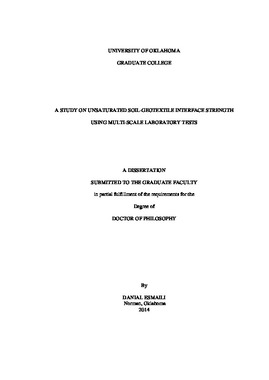| dc.contributor.advisor | HATAMI, KIANOOSH | |
| dc.contributor.author | ESMAILI, DANIAL | |
| dc.date.accessioned | 2014-12-05T15:04:13Z | |
| dc.date.available | 2014-12-05T15:04:13Z | |
| dc.date.issued | 2014-12-12 | |
| dc.identifier.uri | https://hdl.handle.net/11244/13643 | |
| dc.description.abstract | The performance of marginal soils and their interface with geosynthetic reinforcement can be complex under construction or service loading conditions and may include excessive deformations and loss of strength as a result of wetting. Therefore, design procedures for reinforced soil structures need to take into account the influence of suction on the strength and deformation characteristics of the soil, soil-geosynthetic interface and the resulting factors of safety against failure. Such design provisions are currently not available for reinforced soil structures constructed with marginal soils.
This study presents descriptions and results of multi-scale pullout and interface shear tests on a woven polypropylene (PP) geotextile reinforcement material in a marginal quality soil to develop a moisture reduction factor (MRF) for the pullout resistance equation in the currently available design guidelines. In addition, three (3) 1m-high indoor model embankments and one (1) 1.5 m-high and significantly wider outdoor model reinforced soil embankment were constructed at three different gravimetric water content (GWC) values to study their performance and to determine the MRF value in actual embankment configurations.
All the tests described above were carried out using a lean clay at different gravimetric water content (GWC) values ranging between OMC-2% and OMC+2% and were reinforced with woven polypropylene geotextile reinforcement (OMC: Optimum Moisture Content). The embankment models were instrumented with a total of 67 sensors to measure the soil GWC, matric suction and excess pore pressure, reinforcement strains, earth pressure, and deformations of the embankment models and the test box during the tests.
Results of the pullout, interface tests and embankment models indicate that the reinforcement interface strength and pullout resistance could decrease significantly as a result of the loss in matric suction (e.g. by 42% in pullout/interface tests and 74% in embankment models). It is concluded that wetting of the soil-geotextile interface during construction or service life of a reinforced soil structure can measurably reduce the interface strength and pullout resistance of the geotextile reinforcement resulting in lower factors of safety for their stability which needs to be accounted for in design. Results of the study will be also useful to estimate the difference in the pullout capacity and interface shear strength of geotextile reinforcement in a marginal soil when placed at different GWC values during construction. | en_US |
| dc.language | en_US | en_US |
| dc.subject | UNSATURATED SOIL | en_US |
| dc.subject | MOISTURE REDUCTION FACTOR | en_US |
| dc.subject | REINFORCED SOIL STRUCTURE | en_US |
| dc.title | A STUDY ON UNSATURATED SOIL-GEOTEXTILE INTERFACE STRENGTH USING MULTI-SCALE LABORATORY TESTS | en_US |
| dc.contributor.committeeMember | MILLER, GERALD | |
| dc.contributor.committeeMember | CERATO, AMY | |
| dc.contributor.committeeMember | ZAMAN, MUSHARRAF | |
| dc.contributor.committeeMember | GRAMOLL, KURT | |
| dc.date.manuscript | 2014-12-04 | |
| dc.thesis.degree | Ph.D. | en_US |
| ou.group | College of Engineering::School of Civil Engineering and Environmental Science | en_US |
| shareok.nativefileaccess | restricted | en_US |
